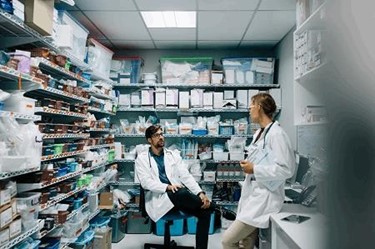How These Hospital Stakeholders Can Benefit Biosimilar Commercialization

By Anna Rose Welch, Editorial & Community Director, Advancing RNA

Just over two years ago, I spoke with Ruediger Jankowsky, managing director of Cinfa Biotech, about the company’s approach to biosimilar development, which uses the pharmacist’s perspective. Cinfa Biotech was launched just four short years ago as a subsidiary of the Cinfa Group, which was founded by pharmacists 50 years ago. When I wrote my first article on this burgeoning biotech in 2015, the company was in the midst of developing its lead candidate, B12019, a biosimilar of Neulasta (pegfilgrastim). So far, the company’s hard work seems to be paying off. In October, the European Medicines Agency (EMA) accepted B12019’s marketing authorization application (MAA) for review, and Cinfa Biotech has started U.S. partnering to bring the pegfilgrastim biosimilar to the U.S. market. Given the number of challenges companies have faced in the development and approval of this particular molecule, I was excited to touch base with Jankowsky again to see how Cinfa Biotech’s perspective on biosimilar development has evolved since we last spoke.
 As Jankowsky described, “It has become very clear the decision to use biosimilars is not made by a single group of professionals — for instance, physicians.” Obviously, doctors and patients are central stakeholders in these decisions. But, in Cinfa Biotech’s time preparing for regulatory submission and, hopefully, a future product launch, Jankowsky has noted the increasingly significant role pharmacists play in educating doctors. Much of this comes down to their holistic method of approaching biosimilars — and this was integral in establishing the company’s rationale for development.
As Jankowsky described, “It has become very clear the decision to use biosimilars is not made by a single group of professionals — for instance, physicians.” Obviously, doctors and patients are central stakeholders in these decisions. But, in Cinfa Biotech’s time preparing for regulatory submission and, hopefully, a future product launch, Jankowsky has noted the increasingly significant role pharmacists play in educating doctors. Much of this comes down to their holistic method of approaching biosimilars — and this was integral in establishing the company’s rationale for development.
“As manufacturers, not only is our mission to supply a high-quality product in a sustainable way, but we also are charged with explaining our products,” Jankowsky offered. Interacting with pharmacists whose interest in biosimilars encompasses all aspects — from science to economics and supply chain logistics — has been a beneficial stepping stone for Cinfa Biotech on its path toward commercialization.
Why Biosimilar Developers Shouldn’t Forget Pharmacist Education
As companies approach regulators and the market with their biosimilars, a key component of commercialization is educating stakeholders. But the information each stakeholder needs is not always the same. At conferences, I’ve heard several patient advocacy groups stress that safety and efficacy need to be the loudest message the industry imparts to patients, regardless of indication. When it comes to physicians, safety and efficacy remain key components; however, they’re more likely to look at it from a clinical level. We’ve heard, time and time again, physicians need to be convinced the products are clinically equivalent in terms of pharmacokinetics (PK), efficacy, and safety. Now, this isn’t to say patients and physicians aren’t interested in knowing anything else about how the products were developed and approved — and many initiatives have been launched to inform these two key stakeholders about the (basic) ins-and-outs of biosimilars.
But one stakeholder we hear very little about, especially here in the U.S., is the pharmacist. Part of this is because the three biosimilars available in the U.S. are all administered in hospitals or clinics. But in Europe, interaction with hospital pharmacists has proven quite valuable from an education standpoint. It’s also helped Cinfa Biotech determine the best ways to deliver information on biosimilars. As Jankowsky explained, pharmacists, too, must be reassured of biosimilars’ efficacy and safety. But they’re also seeking information about the biosimilar regulatory pathway, the data required for biosimilar approval, and the company’s development process, in addition to what we might naturally expect: price, formulary listings, supply chain robustness, and product quality. In fact, Jankowsky’s interactions with pharmacists have shown they are “information hubs for physicians.”
“Pharmacists complement the knowledge and information doctors may already have or are seeking,” explained Jankowsky. “The doctor must be convinced of a product’s safety and efficacy, but the question becomes, what is the appropriate vehicle with which to convince the doctor? What type and amount of data must we provide? This is where the pharmacist comes in.”
For one, pharmacists have shown great interest in unpacking the clinical study design of a biosimilar — especially that of Cinfa Biotech’s B12019 clinical program. Instead of carrying out a PK comparability study and analyzing safety and efficacy in a target population, Cinfa Biotech chose to test for similarity in a healthy volunteer population. This, naturally, gives rise to questions about why the trial includes healthy volunteers, rather than patients, and why this might be a more sensitive model for the product. Pharmacists also expressed interest in topics that are typically more “in the weeds,” if you will — for instance, the study’s endpoints and statistical power.
As Jankowsky explained, “It was much more sensitive to test for similarity in a healthy volunteer population. Not only did we have the advantage of a biomarker — absolute neutrophil count — which also works in healthy volunteer populations, it made more sense to test for antidrug antibodies in patients with intact immune systems.”
Similarly, pharmacists are much closer to certain forms of product documentation, for instance, the summary of product characteristics (SmPC) documents or the European public assessment reports (EPARs) published by the EMA. In the EU, each product is approved with an SmPC, which comprises information on the treatment’s indications, dosages, administration methods, warnings/precautions, and the drug’s mechanism of action and clinical details. Similarly, an EPAR is published for every medicine receiving EMA approval and contains the agency’s scientific assessment of the product, including the company’s clinical data. According to Jankowsky, pharmacists’ training enables them to easily access and glean the most important information from these publications. They’re then able to analyze and prepare that information to be best communicated to physicians.
Mapping The Hospital Decision-Making Process
It’s been said before that many of the reimbursement mechanisms implemented abroad cannot necessarily be carried over into the U.S. (or from country to country), given the vast differences among healthcare systems. Jankowsky also acknowledged, it’s impossible to have a homogenous picture of hospital decision making, given the diversity of each medical system from country to country. But I’d argue Cinfa Biotech’s journey sets the stage for the conversations companies looking to enter the U.S. market should be considering.
I recently wrote an article emphasizing the challenges companies face when building closer relationships with payers. One piece of advice was to uncover more information about payer’s different business models and how decisions are made in each organization. In the same way, U.S. hospital systems — a good example being the integrated delivery networks like Kaiser Permanente — offer similar opportunities for companies to learn how decisions are made and how companies can begin meeting needs.
Though the pharmacist has played a particularly important role in Cinfa Biotech’s market strategy, Jankowsky pointed out that, to be successful with biosimilars, companies do need to take a multi-stakeholder approach. “It doesn’t make sense to focus on one group of stakeholders — for instance only patients or pharmacists,” Jankowsky stated. “You have to address them all, but using the appropriate channels.”
As such, during the development of B12019, Cinfa Biotech set out to understand not just pharmacists’ role, but also the other parties involved in the decision-making process in hospitals. Of course, this varies depending on the hospital, the country, and, sometimes, even the region. But Jankowsky pointed out, in addition to the pharmacist, another important stakeholder to focus on is the hospital controller, or the finance specialist. The importance of pricing and the sustainability of hospital finances cannot be overstated here, and, indeed, is one of the forefront benefits of biosimilars. But sustainability also extends beyond finances into the supply chain. “Decision makers in hospitals want to know that, once they announce the tender, they don’t just get the best price and then realize the supply of that medicine has vanished after one year,” he explained.
In an interview earlier this year, the CEO of Pfenex pointed out the integral role a stable supply chain will play in payers’ eyes as they take the reins and begin promoting biosimilar use. There are two particular aspects to consider when it comes to the supply chain. Obviously, one of the first things hospital stakeholders consider is the quality of the company’s supply chain. “How can you convince a pharmacist you can deliver the product six months from now?” Jankowsky asked. In particular, these professionals will consider the locations of a company’s warehouse and the procedures established to ensure a product gets to its end destination should, for instance, a delivery truck break down.
Jankowsky also highlighted hospital pharmacists’ interests in a product’s stability data. Though biosimilars must be highly similar to their originator molecularly and clinically, a biosimilar does not have to demonstrate highly similar stability data to the originator. Because of this, a biosimilar maker could strive to develop its product with a longer shelf life than that of the innovator. According to Jankowsky, even adding one day to a biosimilar’s shelf life outside of the fridge would be a major benefit for the pharmacist.
Throughout our conversation, Jankowsky highlighted the balance a biosimilar manufacturer must maintain between developing a biosimilar and communicating about it with stakeholders. The ultimate goal for any biosimilar development program is to follow the scientific rationales and principles established by the regulators. But it also comes down to the question of how you would convey your product’s story to the stakeholders in the market. Following potential regulatory approval by the EMA, Cinfa Biotech’s challenge becomes addressing the aforementioned development- and supply chain-related questions. “These questions posed by the pharmacists all translate to the actions we need to take,” Jankowsky added.
Regardless of where a company hopes to approve and launch a product — whether it be in the U.S., EU, or the emerging markets — success comes down to meeting several basic needs in the global biosimilar market today. “We have to make sure we can meet our customers’ and the market’s need, which is not only by supplying the product, but also by sharing the accompanying information in the best way to ensure it is understood.”
